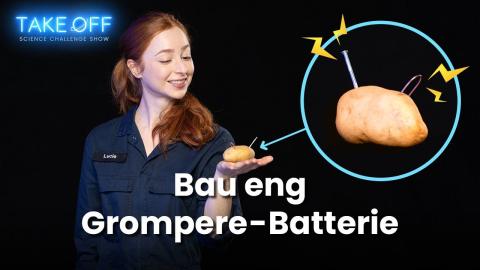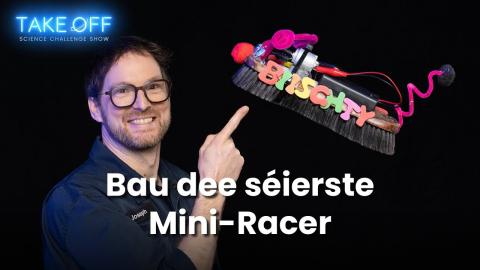Production: FreeLens
Goal of the Challenge
How can you bring a helium balloon into perfect hover, so it stays at head height without rising or sinking? It's not just about balancing the balloon but also developing a method that quickly works with each subsequent balloon. The team whose balloon hovers in place for at least 5 seconds wins.
Key Points
- Topic: Precision and Coordination
- Duration: 30 minutes
- Teams: 2-4 people
Infobox
Take Off is a scientific science game show where 12 smart young adults face tricky challenges. In each episode, one contestant is eliminated. In the grand finale, the winner takes home a prize of €10,000. The show airs on RTL, RTL Play, and YouTube. Short, entertaining behind-the-scenes videos with contestants and moderators can be found on Instagram and TikTok.
Preparation
Materials (per team of 4 people):
- 4 helium balloons with string
- Various weights, such as:
- 1-, 2-, and 5-cent coins
- Paper clips or wooden clips
- Paper
- Scissors and tape
Here you can watch the episode of Take Off where this challenge appears:
Infobox
The challenge process is based on 4 steps that allow teaching the scientific method: 1. Question, 2. Hypothesis, 3. Experiment/Test, 4. Conclusion. The question is the actual challenge. Students intuitively formulate their hypotheses: How exactly do I best solve the challenge? What method seems most promising? This hypothesis is then tested in the experiment or competition. If different groups have different approaches, different hypotheses are tested. The result then shows which hypothesis was better.
Challenge Question:
How can you bring a helium balloon into perfect balance as quickly as possible?
Hypothesis:
Students form teams of up to 4 people. Initially, they receive 3 of the 4 helium balloons and discuss various ideas on how to balance the balloon.
Experiment
Afterwards, the experiment phase begins. All teams now have 15 minutes (the duration can be adjusted) and try to balance their balloons. They attach weights to the string and test how the different weights affect and can be attached. They should try this several times and develop a method that is particularly quick. They should try this method on several balloons.
Competition: Who has the fastest method?
After the test phase, each team gets a new balloon. Now it's about speed: which team balances their balloon the fastest so that it hovers stable at head height for 5 seconds? Let the teams start one by one and measure the time. Discussion and Reflection
After the competition, the teams discuss:
- Which method was the most effective and why?
Ideal Method:
The heavy weights should first be attached to the string near the balloon to roughly balance the balloon. If the balloon is so heavy that it rests on the table with the weights, weights must be removed. The state to be achieved is that the balloon only supports itself on the table with the string. If you now cut the string at the table level, the balloon should be in perfect balance.
Everyday reference: How does balancing zeppelins work?
To keep a zeppelin stable in the air, it must not only be able to rise and sink but also maintain controlled balance. This is achieved through a combination of ballast control and trim cells (ballonets).
- Ballast control: Water or other heavy materials can be released or taken up to balance the weight. This helps to fine-tune the height and avoid sudden changes.
- Ballonets: These air-filled bags inside the zeppelin hull regulate the gas volume. By blowing air into the ballonets, the density of the zeppelin increases, causing it to sink. If air is released, the lifting gas (helium) can expand, making the zeppelin lighter and causing it to rise.
- Tilt control: By selectively adjusting the propeller position and control surfaces, the zeppelin can also be balanced and aerodynamically controlled.
These mechanisms ensure that the zeppelin not only hovers stably but can also be precisely maneuvered.
Physical Principle
A helium balloon rises in the air because helium has a lower density than the surrounding air. The balloon is thus pushed upwards by the surrounding air, similar to how a balloon rises in water.
The buoyant force of a helium balloon can be calculated using Archimedes' Principle. The general formula is:

Simplified:

Meaning of variables:
FA = Buoyant force (in Newton, N)
ρAir = Density of air (approx. 1.225 kg/m³ at 20 °C and 1 atm)
ρHelium = Density of helium (approx. 0.178 kg/m³)
V = Volume of the balloon (in m³)
g = Acceleration due to gravity (9.81 m/s²)
Example calculation for a 1 m³ helium balloon:

Since 1 Newton is about 0.102 kg, a 1 m3 balloon could lift about 1.05 kg (including the balloon itself).
Standard Balloon
A normal balloon (30 cm diameter) can hold about 14 liters of helium and thus lift about 14 g. Subtracting the weight of the balloon and string, you can attach weights between 5 and 10 g to a balloon.
Here you can find more Take Off Challenges to try out
In unserer Rubrik “Für Lehrer und Eltern” - “Ideen für den naturwissenschaftlichen Unterricht in der Schule” we also have a few science challenges and a lot of experiments that you can easily replicate with your class, complete with full lesson plans. In our „Experimentieren“ section, you will also find numerous experiments to try out yourself.
Author: Joseph Rodesch (FNR)
Editor: Lucie Zeches (FNR)

Die Ausarbeitung dieser Rubrik wurde von science.lu in Kooperation mit dem Script (Service de Coordination de la Recherche et de l´Innovation pédagogiques et technologiques) durchgeführt.



